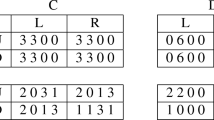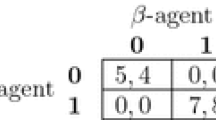Abstract
Consider a two-person simultaneous-move game in strategic form. Suppose this game is played over and over at discrete points in time. Suppose, furthermore, that communication is not possible, but nevertheless we observe some regularity in the sequence of outcomes. The aim of this paper is to provide an explanation for the question why such regularity might persist for many (i.e., infinite) periods.
Each player, when contemplating a deviation, considers a sequential-move game, roughly speaking of the following form: “if I change my strategy this period, then in the next my opponent will take his strategy ‘b’ and afterwards I can switch to my strategy ‘a’, but then I am worse off since at that outcome my opponent has no incentive to change anymore, whatever I do”. Theoretically, however, there is no end to such reaction chains. In case that deviating by some player gives him less utility in the long run than before deviation, we say that the original regular sequence of outcomes is far-sighted stable for that player. It is a far-sighted equilibrium if it is far-sighted stable for both players.
Similar content being viewed by others
References
Aumann, R. J.: 1974, ‘Subjectivity and Correlation in Randomized Strategies’,Journal of Mathematical Economics 1, 67–96.
Aumann, R. J. and Shapley, L. S.: 1978, ‘Survey of Repeated Games’, paper presented at the workshop on repeated games, August 10, 1978, at The Institute for Mathematical Studies in the Social Sciences, Stanford University, Stanford, CA.
Brams, S. J. and Hessel, M. P.: 1983, ‘Staying Power in Sequential Games’,Theory and Decision 15, 279–302.
Brams, S. J. and Wittman, D.: 1981, ‘Non-myopic Equilibria in 2 × 2 Games’,Conflict Management and Peace Science 6, 39–62.
Kalai, E.: 1981, ‘Preplay Negotiations and the Prisoners' Dilemma’,Mathematical Social Sciences 1, 375–379.
Kilgour, D. M.: 1984, ‘Equilibria for Far-sighted Players’,Theory and Decision 16, 135–157.
Nash, J.: 1951, ‘Non-Cooperative Games’,Annals of Mathematics 54, 286–295.
Ramsey, F. P.: 1928, ‘A Mathematical Theory of Saving’,Economic Journal 38, 543–559.
Rubinstein, A.: 1980, ‘Strong Perfect Equilibrium in Supergames’,International Journal of Game Theory 9, 1–12.
Selten, R.: 1973, ‘A Simple Model of Imperfect Competition When 4 Are Few and 6 Are Many’,International Journal of Game Theory 2, 141–201.
Selten, R.: 1975, ‘Reexamination of the Perfectness Concept for Equilibrium Points in Extensive Form Games’,International Journal of Game Theory 4, 25–55.
Von Weizaecker, C. C.: 1965, ‘Existence of Optimal Programs of Accumulation for an Infinite Time Horizon’,Review of Economic Studies 32, 85–104.
Author information
Authors and Affiliations
Rights and permissions
About this article
Cite this article
Aaftink, J. Far-sighted equilibria in 2 × 2, non-cooperative, repeated games. Theor Decis 27, 175–192 (1989). https://doi.org/10.1007/BF00135094
Issue Date:
DOI: https://doi.org/10.1007/BF00135094




